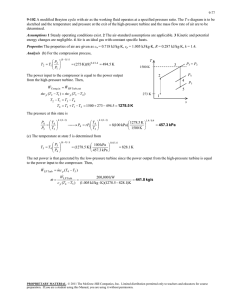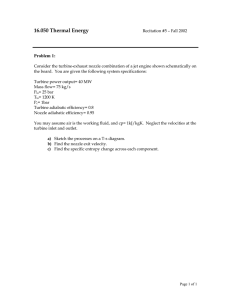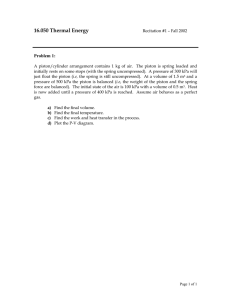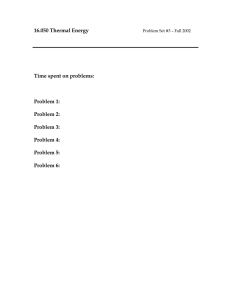Document 14246177
advertisement
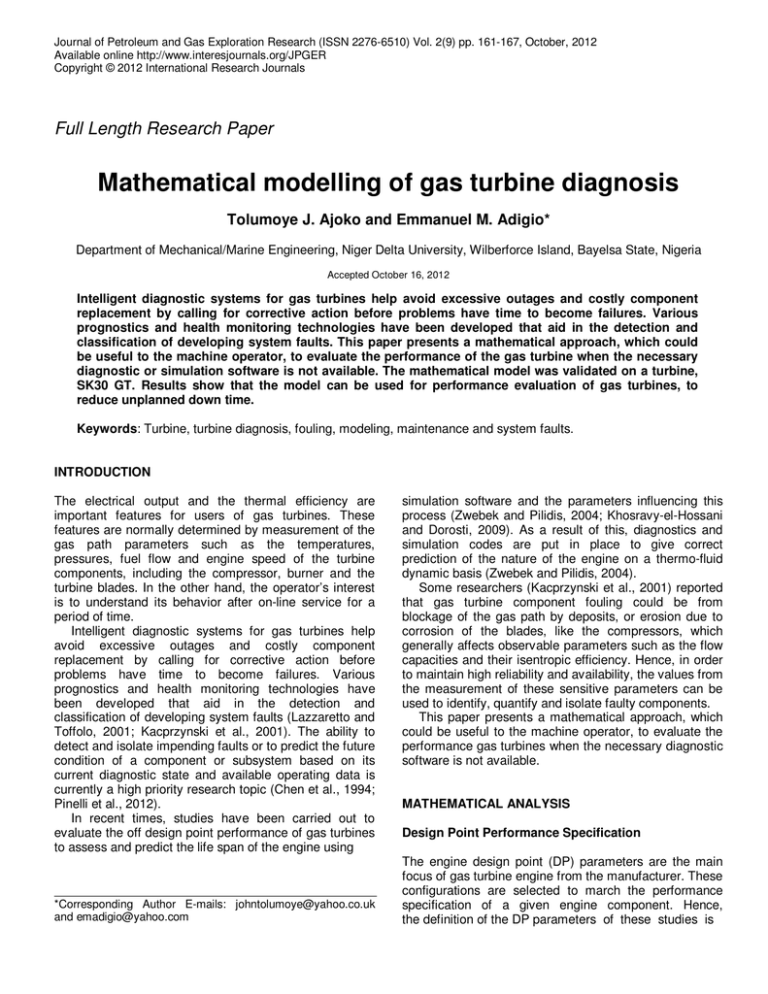
Journal of Petroleum and Gas Exploration Research (ISSN 2276-6510) Vol. 2(9) pp. 161-167, October, 2012 Available online http://www.interesjournals.org/JPGER Copyright © 2012 International Research Journals Full Length Research Paper Mathematical modelling of gas turbine diagnosis Tolumoye J. Ajoko and Emmanuel M. Adigio* Department of Mechanical/Marine Engineering, Niger Delta University, Wilberforce Island, Bayelsa State, Nigeria Accepted October 16, 2012 Intelligent diagnostic systems for gas turbines help avoid excessive outages and costly component replacement by calling for corrective action before problems have time to become failures. Various prognostics and health monitoring technologies have been developed that aid in the detection and classification of developing system faults. This paper presents a mathematical approach, which could be useful to the machine operator, to evaluate the performance of the gas turbine when the necessary diagnostic or simulation software is not available. The mathematical model was validated on a turbine, SK30 GT. Results show that the model can be used for performance evaluation of gas turbines, to reduce unplanned down time. Keywords: Turbine, turbine diagnosis, fouling, modeling, maintenance and system faults. INTRODUCTION The electrical output and the thermal efficiency are important features for users of gas turbines. These features are normally determined by measurement of the gas path parameters such as the temperatures, pressures, fuel flow and engine speed of the turbine components, including the compressor, burner and the turbine blades. In the other hand, the operator’s interest is to understand its behavior after on-line service for a period of time. Intelligent diagnostic systems for gas turbines help avoid excessive outages and costly component replacement by calling for corrective action before problems have time to become failures. Various prognostics and health monitoring technologies have been developed that aid in the detection and classification of developing system faults (Lazzaretto and Toffolo, 2001; Kacprzynski et al., 2001). The ability to detect and isolate impending faults or to predict the future condition of a component or subsystem based on its current diagnostic state and available operating data is currently a high priority research topic (Chen et al., 1994; Pinelli et al., 2012). In recent times, studies have been carried out to evaluate the off design point performance of gas turbines to assess and predict the life span of the engine using *Corresponding Author E-mails: johntolumoye@yahoo.co.uk and emadigio@yahoo.com simulation software and the parameters influencing this process (Zwebek and Pilidis, 2004; Khosravy-el-Hossani and Dorosti, 2009). As a result of this, diagnostics and simulation codes are put in place to give correct prediction of the nature of the engine on a thermo-fluid dynamic basis (Zwebek and Pilidis, 2004). Some researchers (Kacprzynski et al., 2001) reported that gas turbine component fouling could be from blockage of the gas path by deposits, or erosion due to corrosion of the blades, like the compressors, which generally affects observable parameters such as the flow capacities and their isentropic efficiency. Hence, in order to maintain high reliability and availability, the values from the measurement of these sensitive parameters can be used to identify, quantify and isolate faulty components. This paper presents a mathematical approach, which could be useful to the machine operator, to evaluate the performance gas turbines when the necessary diagnostic software is not available. MATHEMATICAL ANALYSIS Design Point Performance Specification The engine design point (DP) parameters are the main focus of gas turbine engine from the manufacturer. These configurations are selected to march the performance specification of a given engine component. Hence, the definition of the DP parameters of these studies is 162 J. Pet. Gas Explor. Res. Figure 1. Schematic drawing of gas turbine; SK30 gas turbine model. Table 1. Gas Turbine engine specification (RollsRoyce). S/N 1 2 3 4 5 6 7 Specifications Compressor Pressure Ratio Exhaust Mass Flow Gross Electrical Power Thermal Efficiency Exhaust Temperature Turbine Entry Temperature Number of Spool(s) necessary before analyzing the corresponding operating conditions. The case study is on an industrial gas turbine (SK 30) at Kolo-Creek in Bayelsa, Nigeria. The specifications (Rolls Royce) are as follows: Design Point Calculations The essence of calculating the design point performance of a gas turbine is to provide prior information on the design and assembly of various engine components and evaluation of the engine geometry. Figure 1 is the schematic diagram of the turbine, SK30-GT. (Table 1) The governing equations for the design point calculation are; Intake P1 = P2 = Pamb 1 T1 = T2 = Tamb 2 W1 = W2 = W3 = Wcold 3 Compressor P3 = P2 × (PRc) 4 γ −1 η is .comp ( PRc ) γ − 1 = T2 −1 T1 CW = Wcold × CPcold (T3 − T2) Combustion Chamber 5 6 η th = SK30 GT 11 93.6kg/s 20MW 40% 415℃ 1 UW QCC FF = FF = 7 QCC FCV 8 Wcold = Whot – FF QCC = Wcold × CPhot (T4 – T3) Turbine 1− η is .turb. = T5 T4 P 1 − 5 P4 γ −1 γ TW = Whot × CPhot (T4 – T5) Other relationships are FF UW W T NDMF = P SFC = 9 10 11 12 13 14 CW = TW 15 In order to reduce large computations; a number of parameters (Table 2) are fixed, with reference to the location of the turbines. Other values (Table 3) are calculated from the governing equations (Equation 1 to 15). Ajoko and Adigio 163 Table 2. Fixed parameters for turbines. S/N 1 2 3 4 5 6 7 8 9 10 11 Parameters Ambient temperature Ambient pressure FCV Comp. Isen. Eff. Turb. Isen.Eff. CP for cold air CP for hot air γ for cold air γ for hot air CC pres. loss Exh. Pres. loss Units °K kPa kJ/kg (%) (%) J/kg/K J/kg/K (%) (%) SK 30 Model 288.15 101.33 43,124 86 86 1005 1150 1.4 4/3 5 1 Table 3. Fixed parameters for turbines (design point). S/N 1 2 3 4 5 6 7 8 9 10 11 12 13 14 15 Parameters Units Comp. inlet temp. (T1) Comp. inlet pres. (P1) Comp. outlet temp. (T2) Comp. outlet pres. (P2) Turb. inlet temp. (T3) Turb. inlet pres. (P3) Turb. outlet temp. (T4) Turb. outlet pres. (P4) Turb. outlet temp. (T5) Turb. outlet pres. (P5) Ther. Eff. Shaft power Fuel flow SFC °K KPa °K KPa °K KPa °K KPa °K KPa (%) KW Kg/s Off Design Point Calculations The design point parameters such as Qcc, CW, and TW are equal to the corresponding parameters of the off design point at any section of the gas turbine engine flow path. Such relationship is known as connectivity or equating process. Hence, the parameter for the off design point (ODP) performance of the gas turbine engine is calculated from the governing equations below (Equations 16 to 19); TIN TOUT PIN POUT T = IN DP TOUT P = IN DP POUT ODP ODP 17 WCold WHot SK 30 Model Values NDMF 288.15 101.33 617.82 1114.63 1158.34 1058.9 688 102.34 40 20000 1.16 5.8 W = Cold DP WHot ODP 19 Each station is numbered (Li et al., 2005), and the thermodynamic parameters is determined based on the upstream component operating performance of the engine. Using an iterative method, the above equations were used to determine the non dimensional mass flow rate which can mainly be affected by fouling of the flow paths. The error can be detected by equating the design point mass flow of the inlet station of the engine to the corresponding parameters of the off design point, e.g. Equation (20) below, (NDMF4 )DP 18 15.486 15.486 2.061 2.061 3.008 3.008 23.989 23.989 W T = 4 4 P4 20 ODP In order to provide a tool for the study of fouling or erosion in the gas flow path, a reference value known as 164 J. Pet. Gas Explor. Res. Table 4. ODP values for compressor fouling, reduction of inlet flow capacity, SK30 GT. Parameters P2 (KPa T2 (°K) P3 (KPa T3 (°K) P4 (KPa T4 (TET) (°K) P5 (KPa T5 (°K) FF (kg/s) Sh. Power (KW) SFC Ther. Eff. 1% 102.35 289.11 1112.93 619.88 1057.29 1158.34 102.18 687.22 1.158 19949.26 5.8105 39.95 Percentage Reduction 2% 3% 4% 103.4 104.46 105.55 290.09 291.08 292.08 1111.06 1109.17 1107.27 621.97 624.1 626.24 1055.51 1053.71 1051.9 1158.34 1158.34 1158.34 102.01 101.84 101.66 686.42 685.62 684.8 1.156 1.154 1.152 19897.52 19845.18 19792.24 5.8104 5.8158 5.8213 39.91 39.87 39.83 5% 106.66 293.09 1105.35 628.42 1050.08 1158.34 101.49 683.98 1.150 19738.68 5.827 39.8 Table 5. ODP Values for compressor fouling, reduction of isentropic efficiency, SK30 GT. Parameters P2 (KPa) T2 (°K) P3 (KPa T3 (°K) P4 (KPa T4 (TET) (°K) P5 (KPa T5 (°K) Fuel Flow ( Kg/s) Sh. Power (KW) -1 SFC (kgs /KW) Ther. Eff. (%) 1% 101.09 288.17 1111.95 617.84 1058.36 1158.34 102.09 691.33 1.1572 19594.3 5.906 39.27 Percentage Reduction 2% 3% 4% 100.88 100.67 100.47 288.17 288.17 288.17 1109.69 1107.42 1105.14 617.84 617.84 617.84 1054.2 1052.04 1049.88 1158.34 1158.34 1158.34 101.89 101.67 101.47 694.16 697.01 699.88 1.15484 1.15248 1.15011 19251.5 18907.3 18561.7 5.999 6.095 6.196 38.66 38.04 37.42 the datum working line, of the design point performance of the two engines are established, calculated from the specifications of the clean engines. Reports (Lakshminarasimha et al., 1974; Zwebek and Pilidis, 2004) indicate that fouling leads to the reduction of the inlet flow capacity and the isentropic efficiency, while erosion leads to increase in the inlet flow capacity. In this report the effect of the changes in parameters was studied by varying the datum mass flow rate and the isentropic efficiency from 1 to 5%. RESULTS Using the relationships provided from the governing equations and by iteration, the engine parameters were calculated while varying the non dimensional mass flow. Results are presented in the tables (Tables 3- 7) 5% 100.26 288.17 1102.86 617.84 1047.72 1158.34 101.26 702.78 1.14774 18214.9 6.301 36.8 DISCUSSION The deterioration result of compressor and turbine fouling of SK30 GT is illustrated graphically on Figures 2 - 5 below. This star plot is produced by employing Equation 21, where the performance deviation is a dependant of the real and degraded parameters. The standard parameters are the performance parameters of design point of the engine and the parameters calculated as a result of degradation are the off design point performance parameters. Following a strategic assumption of compressor fouling up to (5%) for the design point of the gas turbine, that is, on reducing flow capacity and isentropic efficiency, the deviation from the norm is, Deviation = Re al − deg raded X 100 % Re al 21 Figure 2 and 3 represent the reduction of flow capacity Ajoko and Adigio 165 Table 6. ODP Values for Turbine fouling, reduction of inlet flow capacity, SK30 GT. Parameters P2 (KPa T2 (°K) P3 (KPa T3 (°K) P4 (KPa T4 (TET) (°K) P5 (KPa T5 (°K) FF (kg/s) Sh. Power (KW) SFC Ther. Eff. 1% 100.32 285.6 1103.49 612.36 1048.32 1158.34 101.32 674.32 1.1484 21526.12 5.335 43.47 Percentage Reduction 2% 3% 4% 99.304 98.291 97.278 283.01 280.35 277.65 1092.35 1081.2 1070.05 606.79 601.1 595.3 1037.73 1027.14 1016.55 1158.34 1158.34 1158.34 100.29 99.27 98.25 660.77 647.35 634.07 1.1368 1.1252 1.1136 23009.11 24448.56 25844.90 4.941 4.602 4.309 46.93 50.39 53.82 5% 96.264 274.88 1058.91 589.37 1005.96 1158.34 97.22 620.93 1.102 27198.59 4.052 57.23 Table 7. ODP values for turbine fouling, reduction of isentropic efficiency, SK30 GT. Parameters P2 (KPa) T2 (°K) P3 (KPa T3 (°K) P4 (KPa T4 (TET) (°K) P5 (KPa T5 (°K) Fuel Flow ( Kg/s) Sh. Power (KW) SFC (kgs-1/KW) Ther. Eff. (%) 1% 101.09 288.17 1111.95 617.84 1058.36 1158.34 102.09 691.33 1.1572 19594.34 5.906 39.27 Percentage Reduction 2% 3% 4% 100.88 100.67 100.47 288.17 288.17 288.17 1109.69 1107.42 1105.14 617.84 617.84 617.84 1054.2 1052.04 1049.88 1158.34 1158.34 1158.34 101.89 101.67 100.47 694.16 697.01 699.88 1.15484 1.15248 1.15011 19251.47 18907.27 18561.73 5.999 6.095 6.196 38.66 38.04 37.42 5% 100.26 288.17 1102.86 617.84 1047.72 1158.34 100.26 702.78 1.14774 18214.85 6.301 36.8 Figure 2. Effect of flow capacity variation on performance, SK30 GT compressor. 166 J. Pet. Gas Explor. Res. Figure 3. Performance change Vs Isentropic Efficiency Reduction of SK30 GT compressor. Figure 4. Flow Capacity Reduction Effect on SK30 GT Turbine. Figure 5. Performance change vs isentropic efficiency Reduction of SK30 GT turbine. and isentropic efficiency respectively for a SK30 gas compressor. It is observed that the effect of fouling gave rise to an increase in fuel flow by 0.847% and 1.396%, shown in Figures 2 and 3 compared to their design points Ajoko and Adigio 167 and a drastic reduction of shaft power and thermal efficiency, from 1.307% to 0.511% shown on Figure 2 and from 2.108% to 0.77% on Figure 3, all compared to their design points. Turbine fouling results were not different from the effect on the compressor. This is shown in Figures 4 and 5. Apparently, all the measurable parameters shown in figures deviated from their DP values and the most affected parameters are the fuel flow, shaft power, SFC and thermal efficiency as (1.057%, 8.926%, -8.638% and 8%) shown in Figure 5. However, the TET (T4) was chosen as the handle of engine in all the cases. It was also seen that the highest deviation occurred with the fuel flow, shaft power, SFC and thermal efficiency, i.e. 1.057%, 8.926%, -8.638% and 8% respectively shown on Figure 5. CONCLUSION The deterioration test of GT components using mathematical analysis was justifiable due to the following reasons as confirmed in the open literature. Established results reveal the effect of fouling /erosion on industrial GT components. The relevance of this application (use of mathematical analysis for GT deterioration test) in the study can be exposed to GT operators who do not have accessed to GT simulations and diagnostics software. This application can be extended to other models of turbines to provide turbine safety to users in remote areas. ACKNOWLEDGEMENT We acknowledge our colleague and former head of department Dr. P.P. Jombo for his patience and unrelenting encouragement. REFERENCES Chen W, Meher-Homji CB, Mistree F (1994). Compromise: An Effective Approach for Condition-Based Maintenance Management of Gas Turbines, Eng. Opt., 22:185-201 Kacprzynski GJ, Gumina M, Roemer MJ, Caguiat DE, Galie TR, McGroarty JJ (2001). A Prognostic Modeling Approach for Predicting Recurring Maintenance for Shipboard Propulsion Proceedings of ASME Turbo Expo 2001 4-7 June 2001, New Orleans, LA USA, 2001-GT-0218 Khosravy-el-Hossani M, Dorosti Q (2009). Improvement of Gas Turbine Performance Test in Combine Cycle, World Academy of Science, Engineering and Technology, 58:383-386. Lakshminarasimha AN, Boyce MA, Meher-Homji CB (1994). Modelling and Analysis of Gas Turbine Performance Deterioration”, ASME J. Eng. Gas Turbines Power.116 Lazzaretto A, Toffolo A (2001). Analytical and Neural Network Models for Gas Turbine Design and Off-Design Simulation, Int. J. Applied Thermodynamics, 4(4):173-182, ISSN 1301-9724 Li YG, Pilidis P, Newby MA (2005). An Adaptation Approach Gas Turbine Design Point Performance Simulation”, ASM, E Paper 2005GT-68140, 2005, 5:95–105. Pinelli M, Spina PR, Venturini M (2012). Gas Turbine Health State Determination: Methodology Approach and Field Application, Hindawi Publishing Corporation Int. J. Rotating Machinery, Article ID 142173, 14, 2012, doi:10.1155/2012/142173 Rolls-Royce (2011). RB211 GT61 and SK30 GT Industrial Gas Turbine Engine Specification”, available at http://www.rolls-royce.com, (Accessed on the 23rd May, 2011). Zwebek I, Pilidis P (2004). Degradation Effects on Combined Cycle Power Plant Performance – Part III: Gas and Steam Turbine Component Degradation Effect”, ASME J. Eng. Gas Turbines and Power, 126:306-315.

